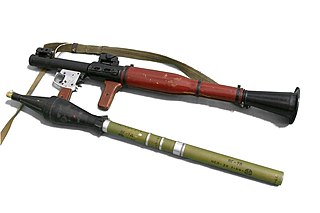
A rocket-propelled grenade (RPG) is a shoulder-fired rocket weapon that launches rockets equipped with an explosive warhead. Most RPGs can be carried by an individual soldier, and are frequently used as anti-tank weapons. These warheads are affixed to a rocket motor which propels the RPG towards the target and they are stabilized in flight with fins. Some types of RPG are reloadable with new rocket-propelled grenades, while others are single-use. RPGs are generally loaded from the front.
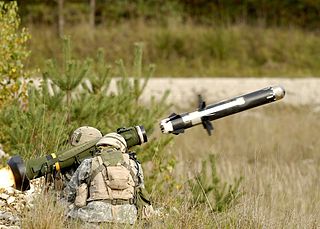
An anti-tank guided missile (ATGM), anti-tank missile, anti-tank guided weapon (ATGW) or anti-armor guided weapon is a guided missile primarily designed to hit and destroy heavily armored military vehicles. ATGMs range in size from shoulder-launched weapons, which can be transported by a single soldier, to larger tripod-mounted weapons, which require a squad or team to transport and fire, to vehicle and aircraft mounted missile systems.

Reactive armour is a type of vehicle armour used in protecting vehicles, especially modern tanks, against shaped charges and hardened kinetic energy penetrators. The most common type is explosive reactive armour (ERA), but variants include self-limiting explosive reactive armour (SLERA), non-energetic reactive armour (NERA), non-explosive reactive armour (NxRA), and electric armour. NERA and NxRA modules can withstand multiple hits, unlike ERA and SLERA.

Armour-piercing ammunition (AP) is a type of projectile designed to penetrate armour protection, most often including naval armour, body armour, vehicle armour.

High-explosive anti-tank (HEAT) is the effect of a shaped charge explosive that uses the Munroe effect to penetrate heavy armor. The warhead functions by having an explosive charge collapse a metal liner inside the warhead into a high-velocity shaped charge jet; this is capable of penetrating armor steel to a depth of seven or more times the diameter of the charge. The shaped charge jet armor penetration effect is purely kinetic in nature; the round has no explosive or incendiary effect on the armor.

The Panzerfaust was a development family of single-shot man-portable anti-tank systems developed by Nazi Germany during World War II. The weapons were the first single-use light anti-tank weapons based on a pre-loaded disposable launch tube, a weapon configuration which is still used today.

The Mk 153 shoulder-launched multipurpose assault weapon (SMAW) is a smoothbore shoulder-fired rocket launcher. It is a portable assault weapon and has a secondary anti-armor ability. Developed from the B-300, it was introduced to the United States Armed Forces in 1984. It has a maximum effective range of 500 metres (550 yd) against a tank-sized target.

The RPG-7 is a portable, reusable, unguided, shoulder-launched, anti-tank, rocket launcher. The RPG-7 and its predecessor, the RPG-2, were designed by the Soviet Union, and are now manufactured by the Russian company Bazalt. The weapon has the GRAU index 6G3.
A tandem-charge or dual-charge weapon is an explosive device or projectile that has two or more stages of detonation, assisting it to penetrate either reactive armour on an armoured vehicle or strong structures.
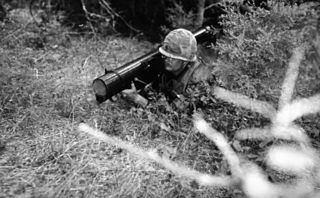
The LAW 80, regularly referred to as LAW 94 in British service, is a man-portable, disposable anti-tank weapon previously used by the British Army and a few other militaries.

The M67 recoilless rifle is a 90 mm anti-tank recoilless rifle made in the United States and later in South Korea. It could also be employed in an anti-personnel role with the use of the M590 antipersonnel round. It was designed to be fired primarily from the ground using the bipod and monopod, but could also be fired from the shoulder using the folded bipod as a shoulder rest and the monopod as a front grip. The weapon was air-cooled and breech-loaded, and fired fixed ammunition. It is a direct fire weapon employing stadia lines to allow simple range finding, based on a typical tank target bridging the lines once in range.
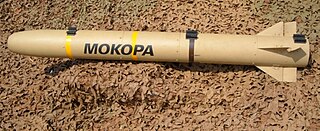
The ZT-6 Mokopa is a South African air-to-ground anti-tank guided missile. As of 2005, it is in its final stages of development, and is being integrated onto the South African Air Force's Rooivalk attack helicopters. The missile is produced by Denel Dynamics, formerly Kentron. The current version uses semi-active laser (SAL) guidance, requiring the target to be illuminated by a laser designator either on the launch platform or elsewhere; though there are alternative guidance packages available including a millimetre-wave radar (MMW) seeker and a two-colour imaging infrared (IIR) seeker.
The Panzerfaust 3 is a modern semi-disposable recoilless anti-tank weapon, which was developed between 1978 and 1985 and first entered service with the Bundeswehr in 1987. It was first ordered in 1973 to provide West German infantry with an effective weapon against contemporary Soviet armor, thereby replacing West Germany's aging PzF 44 Light Lanze launchers and the heavy Carl Gustaf 84 mm anti-tank recoilless rifle manufactured in Sweden.

The RAC 112 APILAS is a portable one-shot 112 mm recoilless anti-tank weapon, designed in France by GIAT Industries. Over 120,000 of the APILAS launchers have been produced, and they are in service with many countries.

Armour with two or more plates spaced a distance apart falls under the category of spaced armour. Spaced armour can be sloped or unsloped. When sloped, it reduces the penetrating power of bullets and solid shot, as after penetrating each plate projectiles tend to tumble, deflect, deform, or disintegrate; spaced armour that is not sloped is generally designed to provide protection from explosive projectiles, which detonate before reaching the primary armour. Spaced armour is used on military vehicles such as tanks and combat bulldozers. In a less common application, it is used in some spacecraft that use Whipple shields.

The Type 98 (PF-98) is a 120mm unguided anti-tank rocket system developed by Norinco for the People's Liberation Army as a successor to the Type 65 and Type 78 recoilless guns. It is also known by its nickname, "Queen Bee". It can be equipped with a firing control system which can calculate and adjust for projectile drop before the rocket fires.

The LRAC F1, officially called Lance-Roquettes AntiChar de 89 mm modèle F1, is a French reusable rocket launcher developed by Luchaire Défense SA, and manufactured in cooperation with Manufacture Nationale d'Armes de Saint-Étienne and was, in the 1970s, marketed by Hotchkiss-Brandt.
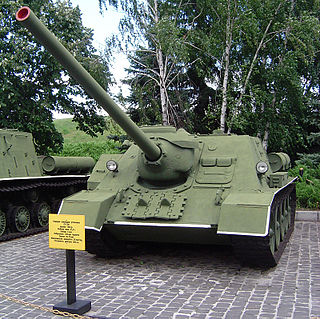
The D-10 is a Soviet 100 mm tank gun developed in late World War II. It originally equipped the SU-100 tank destroyers and was later selected for the T-55 tank, equipping these as late as 1979. On the T-55 the D-10 continues to be in active service in many countries.
Beyond-armour effect is a term coined by Försvarets Fabriksverk (FFV), a semi-governmental Swedish defense firm, while developing the AT4. From the 1980s this phrase was used in its brochures, press releases, weapon instruction manuals and other documentation to denote the post-penetration effect of the AT4's HEAT anti-armour warhead against the interior and occupants of armoured vehicles.

Man-portable anti-tank systems are traditionally portable shoulder-launched projectile systems firing heavy shell-type projectiles, typically designed to combat protected targets, such as armoured vehicles, field fortifications and at times even low-flying aircraft.















